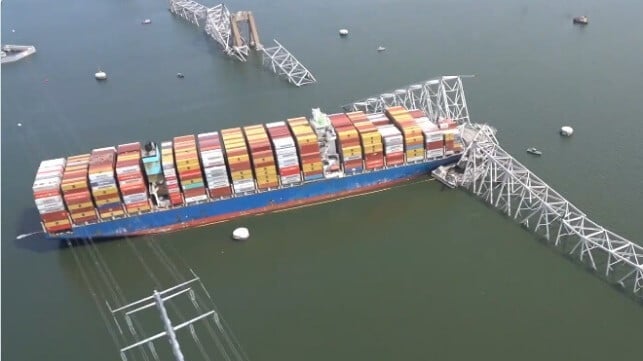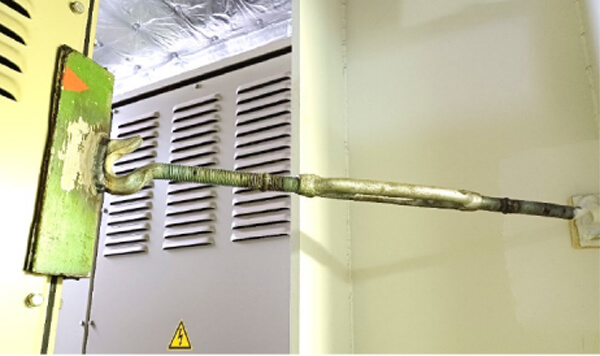US Files $103M Claim Saying Dali was “Unseaworthy” and “Jury-Rigged”

The U.S. Department of Justice filed a scathing civil claim in U.S. District Court today September 18 seeking to recover more than $103 million in costs plus punitive damages from Grace Ocean and Synergy Marine, the owners and operators of the containership Dali. In the most detailed accounting of the disaster which destroyed Baltimore’s Francis Scott Key Bridge and killed six roadworkers, the U.S. alleges the vessel had been “jury-rigged” to keep it at sea despite long-known faults that made the ship “unseaworthy.”
“This was an entirely avoidable catastrophe, resulting from a series of eminently foreseeable errors made by the owner and operator of the Dali,” said Principal Deputy Assistant Attorney General Brian M. Boynton, head of the Justice Department’s Civil Division during a briefing on the suit. During the presentation, the Department of Justice used language calling the situation “careless” and that the companies made “grossly negligent decisions,” which resulted in the containership being unseaworthy. They also accuse the companies of sending the vessel out with an “ill-prepared crew.”
“The owner and operator of the Dali were well aware of vibration issues on the vessel that could cause a power outage. But instead of taking necessary precautions, they did the opposite,” said Principal Deputy Associate Attorney General Benjamin C. Mizer. “Out of negligence, mismanagement, and, at times, a desire to cut costs, they configured the ship’s electrical and mechanical systems in a way that prevented those systems from being able to quickly restore propulsion and steering after a power outage. As a result, when the Dali lost power, a cascading set of failures led to disaster.”
During its inspection of the vessel, DOJ says it found evidence of multiple efforts to correct a known vibration problem. They believe this vibration caused the primary electrical transformer to trip and cut power to the vessel while it was starting the exit from Baltimore harbor.
DOJ writes in the 52-page claim that the transformer had been “retrofitted with anti-vibration” bracing and one of those braces had cracked and was repaired with welds. It cracked again. Supporting the claims of excess vibration, they cite crewmembers who reported other equipment cracking and who said the shaking loosened cargo lashings. In a makeshift attempt to reduce the vibration, DOJ found that engineers welded a metal cargo hook between the transformer and a nearby steel beam.

DOJ says the cargo hook was welded in to reduce vibration that ultimately contributed to the blackout (DOJ filing)
During the transit from Baltimore, DOJ says after the first transformer tripped, the automated system that should have immediately started the backup had been disabled. Crew they say was manually humbling in the dark to reset systems. The emergency generator they also contend took well over a minute to kick in, far longer than required by SOLAS regulation.
After power was restored, it failed a second time, this time DOJ says due to an improper fuel pump. The complaint alleges it was not designed for recovery from a blackout and had been used by the owners to save money. Without the fuel pump running, the fuel pressure was too weak causing the second blackout.
The list of allegations says on the bridge the pilot was struggling through a series of steps attempting to advert the allision. He ordered the port anchor dropped but it was not ready for immediate release as required by regulation. He ordered the ship’s bow thruster but was told it was not available.
U.S. Coast Guard joined the DOJ in today’s presentation. Rear Admiral Laura M. Dickey, Deputy for Operations Capability and Policy of the U.S. Coast Guard said, “Wholly preventable failures by the owner and operator of the Dali caused this tragic incident.” They are also reporting that the crew of the Dali failed to report the blackouts at the dock to USCG as required.
The Department of Justice emphasized that its filing is only a claim for the costs of removing about 50,000 tons of steel, concrete, and asphalt and the efforts to remove the Dali and reopen the channel. They listed off costs ranging from $74 million for the Army Corps of Engineers, $22 million for USCG, $3.5 million for the Department of Labor, $1.8 million for the US Navy, $830,000 for MARAD, and more. They are also seeking punitive damages as a deterrent to other ship operators.
The State of Maryland owned the bridge and DOJ notes the state would have to make claims for the reconstruction. It is believed Maryland will follow the federal claim with its own filing mirroring the federal complaint.
DOJ notes the filing was in response to the claim made by Grace Ocean and Synergy Marine shortly after the disaster where the companies sought exoneration or to limit their liability to approximately $44 million using an antiquated law. An effort is underway in the U.S. Congress to change the law to make international companies liable for their actions and the damage caused. In addition, the families of the victims yesterday filed a lawsuit and the City of Baltimore and local businesses had filed earlier claims.
The current cases are civil claims. The FBI is also investigating and would be responsible for any criminal charges.
DOJ made its filing to meet a court-scheduled deadline for claims. DOJ however notes it is continuing its investigation. They just inspected the vessel, which was scheduled to depart for China. DOJ reports during the recent inspection its officers found, “loose bolts, nuts, and washers, as well as broken electric cable ties” at the transformer and switchboard. They allege the electric system is in “poor condition” and that testing was discontinued due to safety concerns.
Last week, the National Transportation Safety Board released notes from its inspections in April reporting most of the systems were functioning. However, working with representatives from HD Hyundai which built the ship, they reported a loose cable that when tested caused a brief blackout. NTSB is expected to take up to a year to publish its full results.
